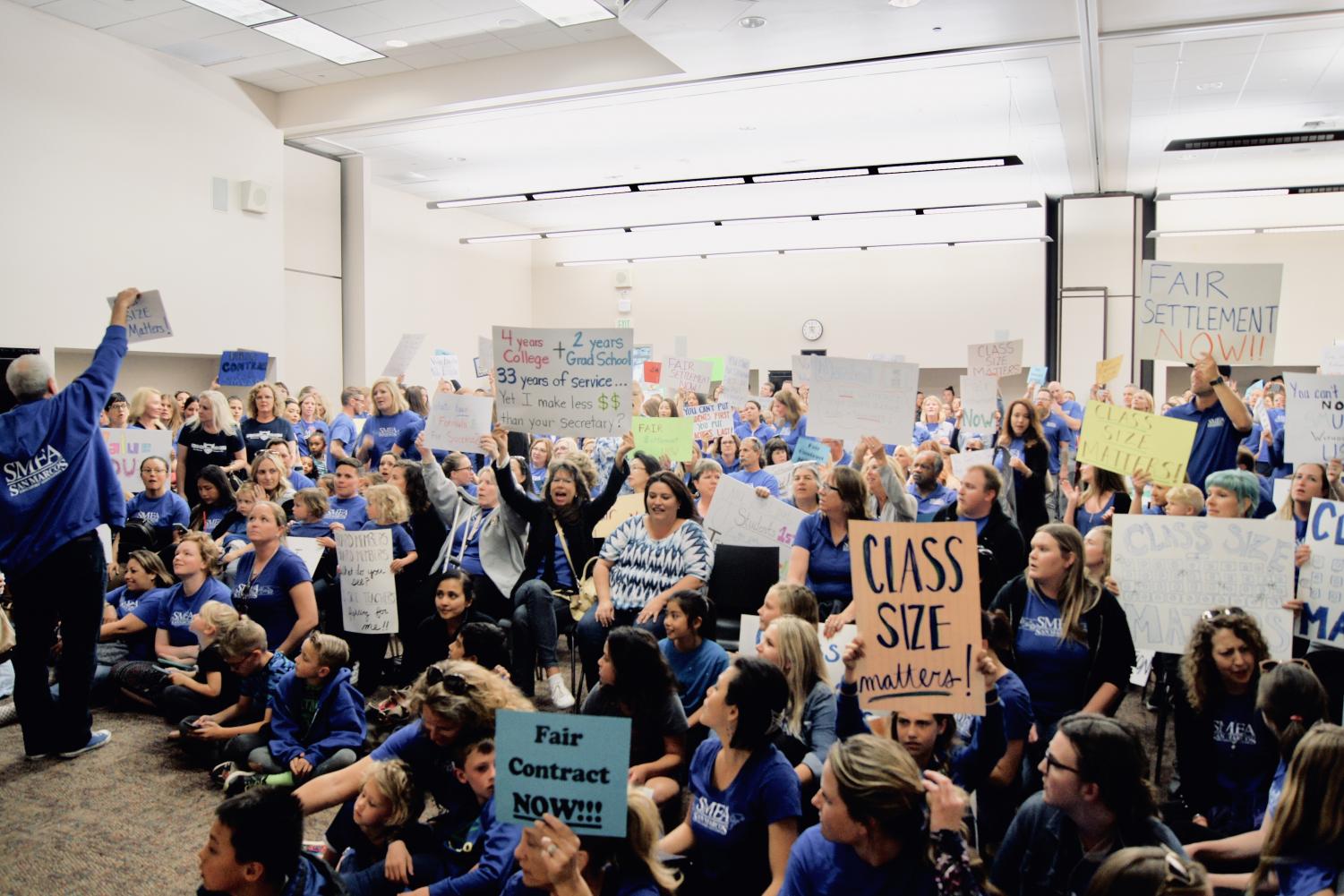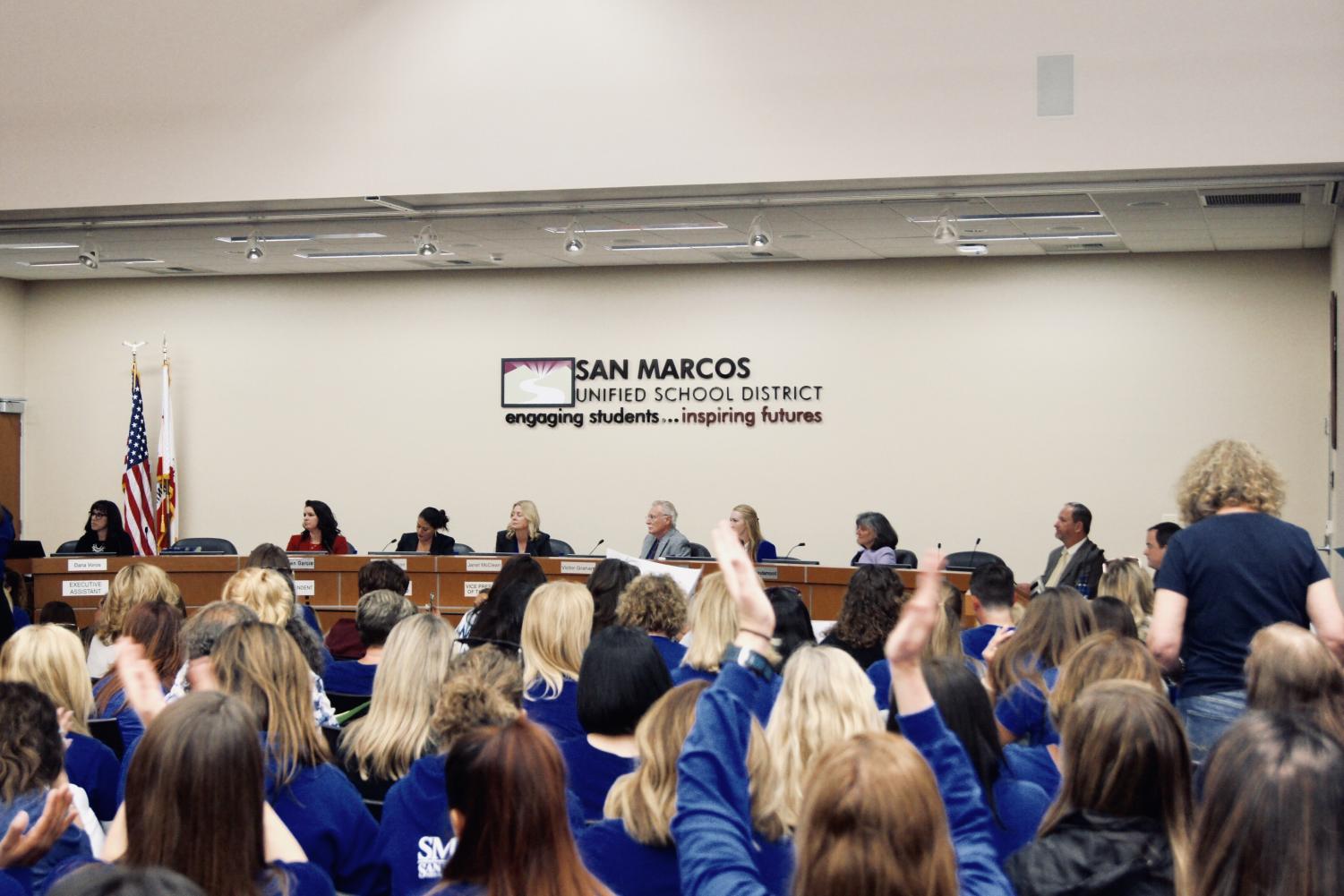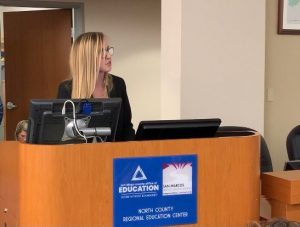SMEA wages protests against SMUSD board over teacher contracts
SMUSD teachers continue their negotiations as they advocate for smaller class sizes and better pay.
May 3, 2019
San Marcos Unified School District (SMUSD) teachers in blue San Marcos Educators Association (SMEA) shirts attended their monthly district meeting on April 16 to urge the SMUSD governing board to see eye to eye on concerns regarding their contracts, bringing with them their children and homemade picket signs. They stormed into the conference room, filling up hallways and stairwells; most meetings usually have around 10 to 15 people in attendance, but this one filled the conference room with a choir of thunderous chants.
“We’ve worked this entire year without a contract. We haven’t agreed to the contract language, and want language in the contract about fair pay, class size, and benefits; we also want to make sure that special education teachers are protected, so we’re here to show support for the bargaining team so that they can keep trying to fight and negotiate for what we want—which is ultimately what we want for students,” said Mr. Coughlin, a music director at Mission Hills High School (MHHS), in attendance at the meeting.
SMUSD teachers are trying to call attention to two major issues: teacher salaries and class sizes. After two years and 16 negotiation meetings, the district and the teacher’s union have been unable to reach a consensus on new teacher contracts.
“The big issue that we want to bring to the table is that our salaries are stagnant. With the economy doing as well as it is, you would think maybe you’d pay your teachers, right?” said Brandon Moore, SMEA executive board member and Middle School Representative for SMUSD.
While the average class ratio in the U.S. is around 20 students per teacher, most classes at MHHS have over 35 students. SMUSD teachers believe hiring more teachers would alleviate the stress of grading around 200 students per assignment.
“The amount of time it often takes teachers to read and comment on hundreds of essays practically eliminates the impact of those comments—by the time the essays are returned to students, most of us barely remember writing them,” said Cameron Parker (12), a student representative at the board meeting in April.
The district acknowledges these concerns, but fears dangerously low cash reserves. Victor Graham, one of the SMUSD board members, claims that around 80 to 90 percent of expenses are already focused on paying teachers alone, placing responsibility of underfunded public schools in the hands of the state.
The “Fourth Place” formula currently used to calculate salaries works by keeping SMUSD teacher salaries in fourth place when compared to local districts. It has been successful for many decades until California changed their funding method in 2013 to the Local Control Funding Formula (LCFF), which funds schools based on average student attendance, but provides more money based on the amount of students that are either economically or culturally disadvantaged (foster youth, English learners, etc.). Before using LCFF, California used the revenue-limit system which provided attendance-based funding while also considering local property tax and accounting decisions. The board claims that this change has hurt SMUSD and led to some initiatives being cut.
“We are now down to the point where we are at zero reserves. We asked the state treasurer to analyze our district and their analysis was that we need to stop the fourth place formula, just like the rest of the school districts. We are one out of a thousand still using it,” Graham said.
Losing faith in the district, the SMEA president started to participate by the 14th meeting, but the May 2 negotiations showed little regard on class size and teacher salaries and no mention of teacher benefits.
“Teachers are upset because the members of our office say that it matters a lot to them, but what the district is offering to the table is very little, especially on issues like class size. Frankly, the districts are happy with what they say is the status quo, so we are trying to get class size reductions as part of the contract,” said Michael Sterling, the chair of the teacher bargaining team.
Cornered, the district must choose between standing ground despite impending protests or accepting the demands of teachers and running the reserves to the ground. The state can intervene in both cases, putting the district board at risk of removal and the teachers into a forced compromise. The next school board meeting is scheduled for May 7 at the SMUSD District Office at 5 pm. The public is invited to attend.


















Diana Diaz • May 29, 2019 at 4:52 pm
As a parent with 2 kids attending MHHS by this fall, I am very upset about the class sizes and the impact that has on my kids and their teachers! When is the next protest/meeting? What can parents do that would make an impact?
Brenda Camacho • May 9, 2019 at 10:05 pm
Amazing article Arvin!! You’re so talented and I admire your work!